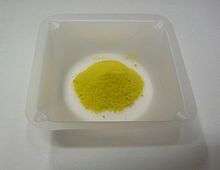Phosphomolybdic acid
 | |
 | |
| Names | |
|---|---|
| Other names
Molybdophosphoric acid; dodecamolybdophosphoric acid | |
| Identifiers | |
| |
3D model (JSmol) |
|
| ChemSpider | |
| ECHA InfoCard | 100.130.014 |
| EC Number | 234-713-5 |
| MeSH | Phosphomolybdic+acid |
PubChem CID |
|
| |
| |
| Properties | |
| H3PMo12O40 | |
| Molar mass | 1825.25 g/mol |
| Density | 1.62 g/ml[1] (hydrate) |
| Melting point | 79-90 °C[1] |
| soluble | |
| Hazards | |
| Main hazards | Oxidiser[1] (hydrate) |
Except where otherwise noted, data are given for materials in their standard state (at 25 °C [77 °F], 100 kPa). | |
| Infobox references | |
Phosphomolybdic acid, also known as dodeca molybdophosphoric acid or PMA, is a yellow-green chemical compound that freely soluble in water and polar organic solvents such as ethanol. It is used as a stain in histology and in organic synthesis
Histology
Phosphomolybdic acid is a component of Masson's trichrome stain.[2]
Organic synthesis
Phosphomolybdic is used as a stain for developing thin-layer chromatography plates,[3] staining phenolics, hydrocarbon waxes, alkaloids, and steroids. Conjugated unsaturated compounds reduce PMA to molybdenum blue. The color intensifies with increasing number of double bonds in the molecule being stained.[4]
Phosphomolybdic acid is also occasionally used in acid-catalyzed reactions in organic synthesis. It has been shown to be a good catalyst for the Skraup reaction for the synthesis of substituted quinolines.[5]
See also
References
- 1 2 3 "Phosphomolybdic acid hydrate - Safety data sheet" (PDF). www.sigmaaldrich.com. 2016-07-18. Retrieved 2018-10-06.
- ↑ "Masson's Trichrome for Muscle and Collagen". StainsFile.
- ↑ "Stains for Developing TLC Plates" (PDF). McMaster University.
- ↑ Burstein, Shlomo (1953). "Reduction of Phosphomolybdic Acid by Compounds Possessing Conjugated Double Bonds". Analytical Chemistry. 25 (3): 422–424. doi:10.1021/ac60075a012. ISSN 0003-2700 – via ACS Publications.
- ↑ Chaskar, Atul; Padalkar, Vikas; Phatangare, Kiran; Langi, Bhushan; Shah, Chetan (2010). "Miceller-Mediated Phosphomolybdic Acid: Highly Effective Reusable Catalyst for Synthesis of Quinoline and Its Derivatives". Synthetic Communications. 40 (15): 2336–2340. doi:10.1080/00397910903245141. ISSN 0039-7911 – via Taylor & Francis Online.